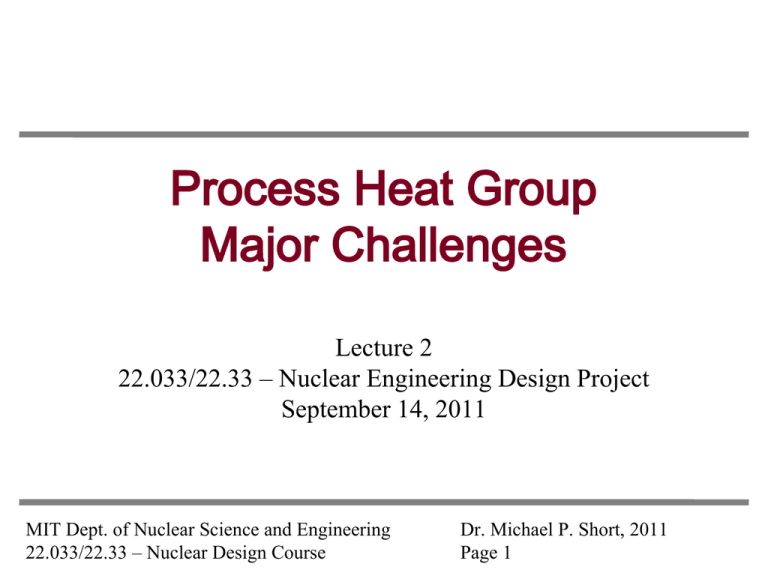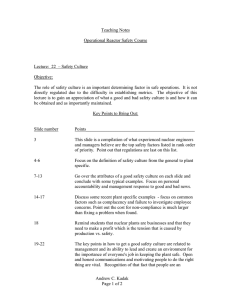
Process Heat Group
�
Major Challenges
�
Lecture 2
�
22.033/22.33 – Nuclear Engineering Design Project
�
September 14, 2011
�
MIT Dept. of Nuclear Science and Engineering
22.033/22.33 – Nuclear Design Course
Dr. Michael P. Short, 2011
Page 1
The Three Challenge Problems
�
Heat exchanger (Hx) design
Heat transport
Heat storage (if necessary)
MIT Dept. of Nuclear Science and Engineering
22.033/22.33 – Nuclear Design Course
Dr. Michael P. Short, 2011
Page 2
First, Some Nomenclature
�
Sensible heating – temperature change
.
�
Q = mcpΔ T
Latent heating – phase change
.
Q = m hfg
Bond energy storage – enthalpy of chemical
reactions
MIT Dept. of Nuclear Science and Engineering
22.033/22.33 – Nuclear Design Course
Dr. Michael P. Short, 2011
Page 3
Where Do We Find Them?
�
Courtesy of the Generation IV International Forum. Used with permission.
Source: http://www.gen-4.org/Technology/systems/gfr.htm
MIT Dept. of Nuclear Science and Engineering
22.033/22.33 – Nuclear Design Course
Dr. Michael P. Short, 2011
Page 4
Heat Exchangers – Fundamental
Parameters
Hx effectiveness (ε)
– Measures how
much heat is
transferred
compared to how
much is possible
ε=1 is ideal, but
practically
Source: Dean Bartlett. “The Fundamentals of Heat
impossible (big Hx)
Exchangers” The Industrial Physicist, AIP, p. 20 (1996)
© American Institute of Physics. All rights reserved. This content is excluded from our
Creative Commons license. For more information, see http://ocw.mit.edu/fairuse.
MIT Dept. of Nuclear Science and Engineering
22.033/22.33 – Nuclear Design Course
Dr. Michael P. Short, 2011
Page 5
Heat Exchangers – Fundamental
Parameters
Diagram of heat exchanger removed due to copyright restrictions. See lecture video for details.
***Source: Ramesh K. Shah, Dusan P. Sekulic. Fundamentals of Heat Exchanger Design. John Wiley &
Sons, Inc. p. 102 (2003).
MIT Dept. of Nuclear Science and Engineering
22.033/22.33 – Nuclear Design Course
Dr. Michael P. Short, 2011
Page 6
Heat Exchangers – Fundamental
Parameters
Q = U·A·F·ΔTlm
Q = Heat transfer rate (W)
�
U = Thermal conductance (W/m2K)
�
A = Heat transfer area (m2)
�
ΔTlm = Log mean temperature difference (K)
�
F = Factor (for flow configuration)
MIT Dept. of Nuclear Science and Engineering
22.033/22.33 – Nuclear Design Course
Dr. Michael P. Short, 2011
Page 7
Heat Exchangers – Log Mean
Temperature Difference (LMTD)
Δ Tlm =
( Δ TH
− Δ TC )
⎛ Δ TH ⎞
ln ⎜
⎟
⎝ Δ TC ⎠
LMTD is a good measure of the effectiveness of simlar heat
�
exchangers of different designs
�
Often, LMTD (counter flow) > LMTD (parallel flow)
�
MIT Dept. of Nuclear Science and Engineering
22.033/22.33 – Nuclear Design Course
Dr. Michael P. Short, 2011
Page 8
Heat Exchangers – Finding Key
Parameters
Figure 1 – A big,
complicated heat
�
exchanger chart
�
Source: Wolverine Tube Heat Transfer
Data Book, p. 93 (2001), accessed at
http://www.wlv.com/products/databook
/ch2_5.pdf
Courtesy of Wolverine Tube, Inc. Used with permission.
MIT Dept. of Nuclear Science and Engineering
22.033/22.33 – Nuclear Design Course
Dr. Michael P. Short, 2011
Page 9
Heat Exchangers – Fundamental
Parameters
For all flow configurations
Hx is “balanced” when C* = 1
NTU = Number of Transfer Units
© John Wiley & Sons, Inc. All rights reserved. This content is excluded from our Creative
Commons license. For more information, see http://ocw.mit.edu/fairuse.
***Source: Ramesh K. Shah, Dusan P. Sekulic. Fundamentals of Heat Exchanger Design. John Wiley &
Sons, Inc. p. 116, 118-119 (2003).
MIT Dept. of Nuclear Science and Engineering
22.033/22.33 – Nuclear Design Course
Dr. Michael P. Short, 2011
Page 10
Hx Flow Types
�
Heat Exchanger Classification by
Flow Arrangement
Multi-pass
Single-pass
Counter-flow
Parallel-flow
Cross-flow
Split-flow
Extended surface
Divided-flow
Shell-and-tube
Plate
Fluid 1 m passes
Crosscounter-flow
Crossparallel-flow
Compound
flow
Parallel
counter-flow
m-shell passes
n-tube passes
Split-flow
Divided-flow
Fluid 2 n passes
Image by MIT OpenCourseWare.
***After Ramesh K. Shah & Dusan P. Sekulic. Fundamentals of Heat Exchanger Design. John Wiley &
Sons, Inc. (2003).
MIT Dept. of Nuclear Science and Engineering
22.033/22.33 – Nuclear Design Course
Dr. Michael P. Short, 2011
Page 11
Parallel Flow vs. Counterflow
�
Counter-flow
Temperature
Temperature
Parallel-flow
tpi
tpi
∆ti
tpo
∆ti
∆to
tso
tpo
tso
tsi
∆to
tsi
Image by MIT OpenCourseWare.
See http://www.engineeringtoolbox.com/arithmetic-logarithmic-mean-temperature-d_436.html
MIT Dept. of Nuclear Science and Engineering
22.033/22.33 – Nuclear Design Course
Dr. Michael P. Short, 2011
Page 12
Hx Flow Configurations
�
Heat Exchanger Classification by Construction
Plate-type
Tubular
PHE
Gasketed
Spiral
Welded
Plate coil
Extended surface
Printed
circuit
Brazed
Plate-fin
Double-pipe
Shell-and-tube
Cross flow
to tubes
Spiral tube
Regenerative
Tube-fin
Rotary
Fixed-matrix
Pipe coils
Parallel flow
to tubes
Rotating
hoods
Ordinary
separating
wall
Heat-pipe
wall
Image by MIT OpenCourseWare.
After Ramesh K. Shah, Dusan P. Sekulic. Fundamentals of Heat Exchanger Design. John Wiley &
Sons, Inc. (2003).
MIT Dept. of Nuclear Science and Engineering
22.033/22.33 – Nuclear Design Course
Dr. Michael P. Short, 2011
Page 13
Hx Flow Configurations - Tubular
�
Courtesy of Wikipedia User:H Padleckas. Used with permission.
Courtesy of Harlan Bengtson. Used with permission.
Source: Wikimedia Commons
MIT Dept. of Nuclear Science and Engineering
22.033/22.33 – Nuclear Design Course
Dr. Michael P. Short, 2011
Page 14
Hx Flow Configurations – Plate
Plate (brazed) type
© Alfa Biz Limited. All rights reserved. This content is excluded from our Creative
Commons license. For more information, see http://ocw.mit.edu/fairuse.
Source: http://www.alfa-biz.com/Gasketed-Plate-Heat-Exchanger.asp
MIT Dept. of Nuclear Science and Engineering
22.033/22.33 – Nuclear Design Course
Spiral type
© Jooshgostar Equipments Manufacturing Company (JEMCO). All rights
reserved. This content is excluded from our Creative Commons license.
For more information, see http://ocw.mit.edu/fairuse.
Source: http://www.hiwtc.com/photo/products/16/02/14/21470.jpg
Dr. Michael P. Short, 2011
Page 15
Hx Heat Transfer Mechanisms
�
Other design parameters should largely
determine this choice
Heat Exchanger Classification by
Heat Transfer Mechanism
Single-phase convection
on both sides
Single-phase convection
on one side, two-phase
convection on other side
Two-phase convection
on both sides
Combined convection and
radiative heat transfer
Image by MIT OpenCourseWare.
After Ramesh K. Shah, Dusan P. Sekulic. Fundamentals of Heat Exchanger Design. John Wiley &
Sons, Inc. (2003).
MIT Dept. of Nuclear Science and Engineering
22.033/22.33 – Nuclear Design Course
Dr. Michael P. Short, 2011
Page 16
Heat Exchangers - Questions
�
What type to use?
�
What working fluids?
�
What geometry? Flow considerations? Laminar or
�
turbulent?
Where is the tradeoff between cost & performance?
Materials concerns?
See also: T. Kuppan. “Heat exchanger design handbook.”
and Som, “Introduction To Heat Transfer.
MIT Dept. of Nuclear Science and Engineering
22.033/22.33 – Nuclear Design Course
Dr. Michael P. Short, 2011
Page 17
Heat Transport
�
Main problem: Get process heat from the
reactor to the hydrogen & biofuels plants
How? Must consider:
–
–
–
–
Temperatures
Losses
Flow rates
Flow transients
MIT Dept. of Nuclear Science and Engineering
22.033/22.33 – Nuclear Design Course
Dr. Michael P. Short, 2011
Page 18
Heat Transport – Long Distance
�
How to model it?
– Thermal resistances
– FEM
– Loop analysis
How to pump it? Forced? Gravity?
Distance from Rx to H2, biofuel plant is one
of the most important parameters
MIT Dept. of Nuclear Science and Engineering
22.033/22.33 – Nuclear Design Course
Dr. Michael P. Short, 2011
Page 19
Heat Transport - Questions
�
What are the constraints? (TH-Rx, TC-H2, TC-bio)
How far does the heat have to go?
Where to take the heat from?
How to transport it?
How to model it? What/where are losses?
Should some of it be stored...
MIT Dept. of Nuclear Science and Engineering
22.033/22.33 – Nuclear Design Course
Dr. Michael P. Short, 2011
Page 20
Heat Storage
�
Heat storage is a way to balance out load
instabilities (capacitive effect)
– Store some heat to run turbines and/or
product factories during transients
– Can help avoid or delay plants loaddumping or load-following
Must balance benefits gained vs. heat lost by
storage
MIT Dept. of Nuclear Science and Engineering
22.033/22.33 – Nuclear Design Course
Dr. Michael P. Short, 2011
Page 21
Heat Storage – Electrical Analogy
�
Source
switch
Load, losses
(transport,
dissipative,
hydraulic)
�
I
Reactor
Heat storage
system
Power (current)
Courtesy of Prof. Eric C. Toolson. Used with permission.
Image source: http://www.unm.edu/~toolson/rc_circuit.html
MIT Dept. of Nuclear Science and Engineering
22.033/22.33 – Nuclear Design Course
Dr. Michael P. Short, 2011
Page 22
Heat Storage Technologies
�
Sensible heat storage
– Simply apply hot fluid to a material, reverse
flow when required
Latent heat storage
– Uses phase change materials (PCMs)
�
– Dependent on melting point, heat of fusion
Bond energy storage
– Dependent on reaction temperature, enthalpy
MIT Dept. of Nuclear Science and Engineering
22.033/22.33 – Nuclear Design Course
Dr. Michael P. Short, 2011
Page 23
Heat Storage – Sensible Heat
Example: Hot gas on alumina fluidized bed
© Prof. Reuel Shinnar. All rights reserved. This content is excluded from our Creative
Commons license. For more information, see http://ocw.mit.edu/fairuse.
Source: R. Shinnar et al. “A novel storage method for
concentrating solar power plants allowing operation at high temperature.” DoE Presentation, Boulder, CO (2011).
MIT Dept. of Nuclear Science and Engineering
22.033/22.33 – Nuclear Design Course
Dr. Michael P. Short, 2011
Page 24
Heat Storage – Sensible Heat
�
Other proposed & demonstrated storage
�
media: Molten salt, concrete
Thermocline test at Sandia National Laboratories
© NREL. All rights reserved. This content is excluded from our Creative
Commons license. For more information, see http://ocw.mit.edu/fairuse.
© Sandia National Labs. All rights reserved. This content is excluded from our
Creative Commons license. For more information, see http://ocw.mit.edu/fairuse.
Concrete TES at U. Stuttgart
See http://www.nrel.gov/csp/troughnet/thermal_energy_storage.html
MIT Dept. of Nuclear Science and Engineering
22.033/22.33 – Nuclear Design Course
Dr. Michael P. Short, 2011
Page 25
Heat Storage – Phase Change
Materials
Source: M. Demirbas.
“Thermal Energy Storage
and Phase Change
Materials: An Overview.”
Energy Sources, Part B,
1:85–95, 2006.
More compact
Layout can be more
complicated
Salts can be corrosive
Graphite foils have
been used to
improve heat
spreading
© Taylor and Francis Group, LLC. All rights reserved. This content is excluded from our
Creative Commons license. For more information, see http://ocw.mit.edu/fairuse.
MIT Dept. of Nuclear Science and Engineering
22.033/22.33 – Nuclear Design Course
Dr. Michael P. Short, 2011
Page 26
Heat Storage – Bond Energy
�
Absorb/Release chemical energy by shifting
chemical equilibrium reactions
– Change temperature, pressure
– Examples: hydration, hydriding,
ammonia/salt reactions
– Chemical reaction should be reversible
MIT Dept. of Nuclear Science and Engineering
22.033/22.33 – Nuclear Design Course
Dr. Michael P. Short, 2011
Page 27
Heat Storage – Questions
�
What temperature(s) is/are required?
�
What materials to use?
�
What capacity to use? (kWh, MWh, Gwh)
�
How does cost scale with size?
�
What are loss rates & pathways?
�
When would it be used, if at all?
�
Where would it be located?
�
MIT Dept. of Nuclear Science and Engineering
22.033/22.33 – Nuclear Design Course
Dr. Michael P. Short, 2011
Page 28
MIT OpenCourseWare
http://ocw.mit.edu
22.033 / 22.33 Nuclear Systems Design Project
Fall 2011
For information about citing these materials or our Terms of Use, visit: http://ocw.mit.edu/terms.


